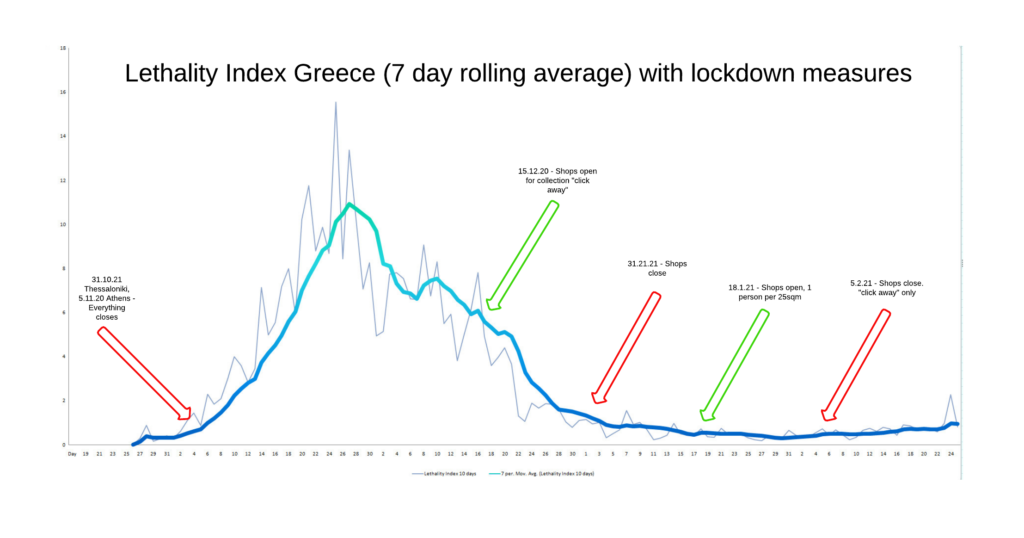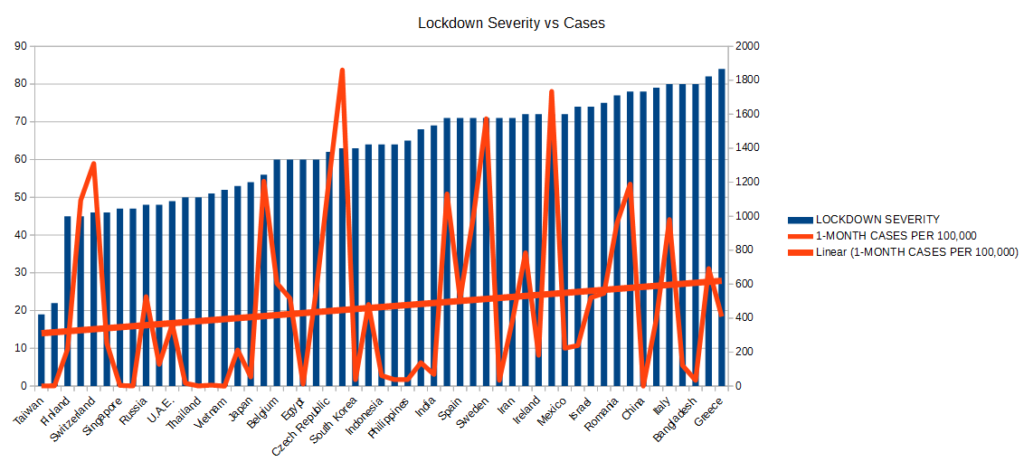
Greece is entering the 5th month of a national lockdown. In this article we will look at the effect of the original lockdown back on the 30th of October and also the effect of the relaxation and tightening of the Greek lockdown measures during this period.
The numbers we will use for this analysis will be the Lethality Index and the tests-to-case ratio.
This what the Lethality Index looks like since the 30th of October

Going through the arrows on the above graphic from left to right.
The first red arrow on the left is the initial lockdown after the summer. At the time the Lethality Index was on a slight uptick and accelerated upwards after. Sweden sees a very similar graph despite the measures imposed being very different.
After the initial lockdown was initiated the test-to-case ratio gradually declined ie worsened for around 18 days, after which it started to reverse.
We are told the the delay between lockdowns and the effect is around 14 days so perhaps we can say the lockdowns did help the situation.
On the 15th of December there was a slight relaxation in the Greek lockdown measures whereby people could go to the shops to collect their products from outside of the shop. This led to a noticeable uptick in traffic on the roads. However the test-to-case ratio (TCR) continued to improve after the relaxation.
On this occasion it is not clear if the tighter measures were having any effect.
On the 31st of December the Greek lockdown measures were re-tightened, we saw no real change to the tests-to-case ratio.
Lockdown appear to have no effect at this time
On the 18th of January there was a relaxation of the Greek lockdown measures whereby shops actually opened and people could go inside, although with one person per 25sq/m. At the time of the relaxation the TCR was 60 and this number worsened from the 18th onwards.
It appears the lockdown may have been achieving something at this point
On the 5th of February the restrictions were re-tightened to collection only from shops. At this time the TCR was 40 and the number has worsened from here.
Lockdown measures appear to not make a difference at this point
Looking at these changes in the restrictions there does not appear to be a pattern the resulting TCRs. Sometimes tightening is followed by an improvement (31st Dec) and sometimes the worsening of the number, continues after the tightening (5th Feb).
The jury is out of the effect of lockdowns on TCRs although the TCR does appear to be the metric the Greek government uses to determine when it will invoke a tightening or loosening of restrictions.
Effect of Lockdowns on the Lethality Index
After the 31st of October the Lethality Index increased markedly. It could be argued that the lockdown limited the damage however the was no improvement in the Lethality Index until almost 30 days after the lockdown was initialised. If the lockdown were the reason for the decline then the delay for measures having an effect cannot be 14 days (because we are told lockdown measures start to have an effect after 14 days).
Either the lockdown measures are ineffective or the 14 day delay is wrong.
Restrictions were relaxed on the 15th of December. The Lethality Index was already improving at this point and the relaxation did nothing to slow down the improvement. Indeed the improvement continued until the 3rd of February, some 7 weeks later.
The relaxation had no effect
Restrictions were tightened on the 31st of Dec but as I covered above, the trend in the lethality index did not change until the 3rd of February.
Tightening had no effect on the trend
18th of Jan, collection from shops, as covered above, improvement trend in Lethality Index largely unchanged
Relaxation had no effect on trend.
5th of February tightening came at a point when Lethality Index was at a turning point for the worse. The number continued to worsen until around the 26th of February where it may have stabilised.
It could be argued tightening has some effect or it could also be argued than tightening had no effect because delay is too long. In short, effect of lockdown restrictions unclear.
Stand out point
Perhaps there is a relationship between lockdowns and the TCR. There appears to be little relationship between Greek lockdown measures and the Lethality Index. Given the the TCR can be effected by the types of tests being down I would says the Lethality Index is a more consistent measure. This would lead to saying lockdowns have an unclear effect on the virus situation.
Greek lockdown measures from a different angle.
The main argument to support lockdowns is that things would have been much worse if they did not happen.
If this is true, that tightening restrictions could have such a massive effect, then logically we can also say when measures are relaxed the effect will also be equally massive in the opposite direction.
Yet we do not see this. We do not see relaxation leading to a dramatic worsening of the situation.
If COVID19 lockdowns have a massive positive effect, they must also have a massive negative effect when they are taken away.
The best test case for this in Greece is the 15th-31st of December period. The COVID19 situation at that time was much worse then than it is today yet we saw no noticeable difference when measures relaxed.
Many more people were dying at that time, if lockdowns were keeping the barbarians at the gate so to speak, we would expect opening the gates to lead to huge problems. It didn’t.
This opening in the 15th of December effectively showed there was nobody behind the gates. We opened the gates and nothing happened.

I don’t think this is a revolutionary conclusion. We can see that COVID19 appears to be unaffected by lockdowns. Looking at the Bloomberg resilience index shows us this.
We can also compare countries which have vastly different lockdown approaches and we can see the curves look broadly similar, Sweden vs Greece for example. (Or perhaps Greece’s measures made the virus more dangerous, looking at the mortality rate)
Again, this is not surprising, the flu seasons we experience follow a similar pattern between countries. What is different is that we do not look for a link between countries or activities when we try to explain the flu season.
Rightly or wrongly we have concluded that influenza is a seasonal virus which is highly contagious but also a virus which we do not have a way of defeating. COVID19 has many similarities with flu yet the official conclusions are vastly different, namely, COVID19 is not a seasonal virus and lockdown measures are effective.
This is the line that is trotted out by governments, however the data seems to tell us otherwise.
Regardless of the measures the data tells us the virus spreads. We can compare different measures in the same country (Greece) and we can compare measures between countries (eg Sweden vs Greece), both comparisons tell us the same thing. Measures seem to have no obvious effect on the virus and the virus is seasonal.





More Stories
News Round-Up
Η Σιωπηλή Νόσος: Οι επιπλοκές που προκαλεί ο Διαβήτης στα υπόλοιπα όργανα
Στα «Νέα Σαββατοκύριακο»: Σκληρό πόκερ για ένα ταξίδι